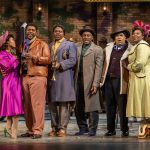2003-10 Vital Source Mag – October 2003
John Hughes Knocks on Heaven’s Door
By John Hughes I was a bleak geek living in a house where the only art was a pair of framed oil portraits of Presidents Washington and Lincoln, and the only music came from my sisters plinking away dispiritedly on an upright piano, because they had to, for piano lessons. There were no plants in my house, there was no poetry, and we watched the television a lot. Knowing no better, I was reasonably happy; but I just knew there had to be something more to life than television, school and the Green Bay Packers. I was 14 years old, living in Brookfield in 1971, surrounded by “Nixon’s the One” bumper stickers and sentiments, lonely in a world which seemed cold and rough — until Bob Dylan tapped me on the shoulder. I bought a Dylan cassette because I liked the cover. I hiked up to the department store (Treasure Island, on Capitol Drive) with my paper boy money, and bought the cassette with the coolest cover. I liked the blue light swirling around Dylan’s curly head on his Greatest Hits, Volume 2 album. I had no idea who he was. I had no idea that he was an icon, a voice for millions of disaffected youth. When I bought that cassette, I was doubling my music collection but increasing my musical knowledge tenfold. The other cassette I owned was James Taylor’s Mud Slide Slim and the Blue Horizon. I plugged in to Dylan and turned on, sitting there at my desk, eating Cheetos, covered in pimples, a revolution occurring in my inner core. I had no idea that this was happening all over the world with other people. I loved Dylan mostly because of his voice. It had so many contours and hollows, I was endlessly fascinated. And he said, “I saw a highway of diamonds with nobody on it.” I’ve never gotten over that image. He said, “There’s beauty in that silver singing river, there’s beauty in that rainbow in the sky, but none of these and nothing else can touch the beauty that I remember in my own true love’s eye.” He said, “Down here next to me in this lonely crowd, there’s a man who swears he’s not to blame. All day long I hear him cry so loud, calling out that he’s been framed.” He made me feel something I’d never felt before, something to do with the mystery of the heart. It seemed essentially good in Dylan’s hands. This was pivotal for a young person with an emerging sexuality and political consciousness, both of which were at odds with my milieu. I would come home from middle- or high school, traumatized by the day’s events, lie down in the middle of my bedroom floor, stare at the ceiling, and listen to Dylan. I loved him deeply. The net effect of his work was like, in the middle of a chorus of voices, this one voice was whispering to me: “You know how, when you’re […]
Oct 1st, 2003 by Vital ArchivesWarren Zevon
By John Hughes WARREN ZEVON The Wind Artemis Records www.warrenzevon.com Before Warren Zevon died in early September, he assembled an all-star cast of friends to help him craft his own epitaph — a final CD recorded in the aftershock of his fatal diagnosis. A songwriter’s songwriter, he maintained great integrity throughout his career, no matter what the prevailing fashion. May he rest in peace. We are treated to much more than a parting novelty. In The Wind, Zevon takes us on a tour of American music. He sings like Woody Guthrie on the opening cut. From there he tours us through a Springsteen-esque rocker, hyper-charged by Bruce himself; and the Dylan classic “Knockin’ on Heaven’s Door” done with a touch of gospel. He gives us a blues romp and songs sung like Jackson Browne and Willie Nelson. “Prison Grove,” a standout effort that could have been pulled from the Lomax field recordings songbook, is highlighted by a chain-gang chorus of Springsteen, Browne, Jordan Zevon, Jorge Calderon, T Bone Burnett and Billy Bob Thornton. There are also two sensitive, lovely ballads, written and played straight, sung just like Warren Zevon. He deploys his friends — especially Ry Cooder, Emmylou Harris, Springsteen and Calderon — with maximum efficiency. It all adds up beautifully, for ten songs. But all this is just so much clearing of the throat as Zevon prepares us for song 11, the dramatic finale. In the final song of his life, Zevon blesses us with an extraordinary moment — a dying man bids adieu. He wrote the song for his two children, but sings it for everyone. He taps deep emotion without being maudlin. He stands tall in his deathbed. His last request? “Keep me in your heart for awhile.” Yes, Warren. Will do.
Oct 1st, 2003 by Vital ArchivesHalloween Costumes
By Lucky Tomaszek I have always loved Halloween. As a girl, I remember that the costumes in our family were consistently fun and well thought-out. We lived in a small town, so the treats from Beggar’s Night were tasty and plentiful. In addition to timeless favorites like Bit O’ Honeys and mini candy bars, lots of families prepared (and we were allowed to eat) caramel apples, popcorn balls and cookies. And, as my birthday falls the day before Halloween, we typically had a fun party that revolved around costumes and Trick or Treating. My mother has a long history with the theater (and drama of all sorts). She would spend lots of time with us helping put together great costumes. There was never a lot of money to spend on those things, but it seemed like she whipped up creative, even amazing characters for us out of scraps, cheap makeup and determination. It always made me feel so good to show up at the school Halloween party with the best costume. My love of Halloween has continued into my adult life, and now I get to share it with my kids. Following in my mother’s footsteps, I look forward every year to helping my children create one of a kind costumes. Kids love to dress up, and with a little effort, you can take store-bought costumes, street clothes, or footie pajamas and make them feel like they are the best dressed Trick or Treater on the block. And when you do it yourself, you’re only limited by imagination. In addition to traditional fabric stores, places like Drew’s in Wauwatosa, Michael’s and even Wal Mart sell craft materials like fabric, feathers, beads, paint and felt. Grease paint makeup can be had at any Walgreen’s, Target, or other discount store. And if you need at least one major prop, head for a Bartz’s, Toys R Us, or one of the many Halloween specialty stores that crop up this time of year. Personally, I like American Science and Surplus. They have strange and wonderful junk all year, and there are lots of things available that make a kid’s costume truly unique, from squeaking dinosaur tails to glow sticks and dry ice packets. It’s amazing how cheaply you can sew (or glue) some felt onto a sweat suit and end up with a warm and original costume that will thrill your children and dazzle your neighbors. To allow your kids to be able to Trick or Treat without covering their costume with a coat, buy everything a little big and wear lots of layers underneath. My kids have gone out with two pairs of tights, leggings, a t-shirt, a turtleneck, socks and mittens underneath their costumes on extra cold Halloween nights, and have fared very well. Kids feel good when they look spooky or scary or beautiful. And they feel even better when they and their parents take the time and the effort to create a truly unique costume. There are plenty of good […]
Oct 1st, 2003 by Lucky TomaszekElvis Costello
By Jon M. Gilbertson ELVIS COSTELLO North Deutsche Grammophon www.elviscostello.com As he grows older and perhaps wiser, Elvis Costello increasingly resembles another former enfant terrible from the UK: writer Martin Amis. Both sons of notable practitioners of their respective arts, both more famous than their fathers, they are almost embarrassingly skillful and variegated: Amis the novelist, reviewer, journalist; Costello the explorer of New Wave, Tin Pan Alley, country & western, rhythm & blues. Costello’s latest album, North, finds him meditating in the gorgeously melancholy shadows once inhabited by Cole Porter, the Gershwins et al. He’s been there before, but never so deeply. His facility with the forms – particularly the alternately lush and spare arrangements, which include a horn nonet, the classically trained Brodsky Quartet, and Attractions keyboardist Steve Nieve — recalls the clarion blurb on Amis’ last paperback, 2002’s The War Against Cliché: Essays and Reviews 1971-2000: “Is there anything Martin Amis can’t write about?” Indeed. Is there any musical style Elvis Costello can’t master? More to the point, does a creative chameleon eventually forget or lose sight of what he’s best at? The most devoted Costello fan, asked to define the man’s essence, would reach for the early work, its electric guitars and tumbling wordplay. Yet North deserves better than polite applause. Even more than Painted From Memory, Costello’s much-lauded collaboration with Burt Bacharach, these 11 songs weep with the admission of a romanticism usually thwarted by irony or buried in anger. From the desperation of “You Left Me in the Dark” to the serenity of “I’m in the Mood Again,” North is about passionately careful artistry. It is about Elvis Costello’s cracked but strong baritone register. It is about grace in the teeth of love. Above all, North is about hopes: betrayed, dashed, renewed, fulfilled. The album represents the outpouring of a beating heart, not another notch in an artist’s impressive catalog.
Oct 1st, 2003 by Vital ArchivesIs this thing on?
By Frizell Bailey The view from Ben Merens’ 23rd floor office is spectacular. It sweeps the eastern half of downtown, with the river and the lake as bookends. Admittedly, not at all what you’d expect from the offices of a public radio station; a ClearChannel office, maybe. “It’s a little embarrassing,” Merens says with a smile. He explains to visitors and would-be public radio members and underwriters that Wisconsin Public Radio got the space at a steal when occupancy in the building was low. Merens is the host of a call-in talk show that airs from 3 p.m. to 6 p.m. on the Ideas Network, broadcast in Milwaukee at 90.7 FM. The show covers current events and includes expert guests, policy makers and commentators. It’s a perfect fit for Merens. But it took a while to get there. PR = Public Radio. Merens studied Public Relations at the University of Wisconsin in Madison. He admits that he didn’t really know what career he wanted to pursue while studying at UW. He recalls one of his professors hinting that Public Relations might not be for him. “She said ‘you’ll never practice a day in PR.’ I don’t know why she said that; I didn’t know it, but she was right. I never really have.” After graduation, he took a year off from school to study with the Second City Theatre Group in Chicago. He got a job doing singing telegrams to pay the bills. He eventually went back to school and received his Masters from Northwestern University’s Medell School of Journalism. Over the next few years he worked in print and radio in Long Island and Chicago, but he still hadn’t found his niche. In the late 80s, Merens was teaching at Chicago’s Columbia College. He remembers telling his class that it was not enough to simply get your degree without a plan for what you wanted to do once you completed your studies. He challenged them to think about what they wanted out of their career. They, in turn, challenged him. He had to admit that he didn’t know what he ultimately wanted to do, but he promised them that he would have an answer for them by semester’s end. He soon realized that what he liked most about journalism was asking questions and conducting interviews. “I was the kid in school who was always asking questions. My teacher would say ‘what is going to become of you, you’re always asking questions?'” Fast forward. Merens has been with Wisconsin Public Radio for twelve years, a job he might not have noticed had his wife not brought it to his attention. “I was looking for work and my wife said ‘have you read the paper today?'” It was Sunday night and he was in no mood to sift through the classifieds. But he took the paper from her and noticed the ad for a host/producer for a nightly business show on Wisconsin Public Radio. Ben landed the job, and in an […]
Oct 1st, 2003 by Frizell BaileyNappy Roots
By John Hughes NAPPY ROOTS Wooden Leather Atlantic www.nappyroots.com Nappy Roots are the best musicians to come out of Kentucky since Joan Osborne, and a lot more fun. On this CD, like a champion racehorse at the Kentucky Derby, they burst out of the gate, grab an early lead, hold the pace despite some stumbles, and surge to a win. I am a 46-year-old white male, on whom the charm of hip-hop is often lost, and I can’t get enough of Nappy Roots. They have an infectious groove on 15 of these 18 songs; if you’re at all well they’ll get you on your feet, shaking it and clapping. The glorification of violence and misogyny so prevalent in much of rap is absent here. These gentlemen obviously have been listening to country blues, traditional soul gospel, Caribbean rhythms and Philadelphia soul, as well as hip-hop. But they are not at all derivative. They carry their forbearers in their hearts while living in the present, and create a vibe of joy and freedom. Nappy Roots are deeply proud of their rural background, and consequently remind me of the defunct, lamented, Arrested Development. But these ambassadors of the Bluegrass State are more lovable than Speech and Company, because Nappy Roots deploy funny vocal stylings, and avoid prophetic pretension. It’s just a rhythm party from start to finish, marred by a few bad songs, but ultimately ready for the Winner’s Circle. Yea, Kentucky!
Oct 1st, 2003 by Vital ArchivesThe Upscale Vagabond
By Frizell Bailey One evening I was walking down Brady Street when a couple sitting on the sidewalk near Jimmy John’s asked me for some spare change, a fairly common occurrence. Usually, depending on my mood, I fork over whatever I happen to have in my pocket or say I don’t have any cash on me if my pockets are empty. The pair was a young couple, probably in their early to mid twenties. Their black lab-ish dog sat next to them wearing a bandana. Given my situation at the time, the term “spare” change had taken on a much more literal meaning. Struggling to balance graduate school and a personal life out to kill me, working had become sporadic at best. I politely told them that I had no change to offer and continued on my way. But a block or two down the street it occurred to me that there was something rather odd about this down-on-their-luck trio. While the two humans looked sufficiently scruffy to be panhandling, the dog looked decidedly less needy. What nerve they had, I thought to myself, to ask me for money when they have a dog that looked like it had never missed a meal or bath. The couple, I decided, must be dirty and un-kept out of personal choice, or to scam suckers like me for change. This got me thinking about myself and my own situation. My well kept appearance belied the fact that I had no job, very little money, and no place of my own to live. Despite this I had managed, through the kindness of others and other more creative means, to fairly closely maintain my standard of living. This was the genesis of the upscale vagabond. The Ethos of the upscale vagabond. The upscale vagabond ethos was borne out of necessity. Since college I have acquired certain tastes. Though not quite caviar in scale, my personal likes are definitely not the ramen noodle tastes of my undergraduate days. Needless to say, even though I was temporarily “down on my luck,” I had no desire to return to this lifestyle. Upscale vagabond existence is about living above your means, but without actually paying for it. It’s about being able to sip suds or martinis when you can really only afford fountain drinks with free refills. It’s who you know. The adage “it’s not what you know but who” applies not only to getting a great job, but also to having a fun and fulfilling social life, especially when money’s a little tight. When you’re broke is not the time to be timid or introverted. Trust me, people will exchange cocktails for lively conversation. On the question of libations, the first thing you want to do is chat up your bartender. They’re at work so they have to be there. And especially if they are working a shift alone, they’re probably jonesing for a little conversation, particularly with someone who is not either tanked out of their mind […]
Oct 1st, 2003 by Frizell BaileyMarj Hahne
By Russ Bickerstaff MARJ HAHNE notspeak When the instruments and singing voices are left out of audio, all that remains is the music of spoken ideas. In her poetry CD notspeak, Marj Hahne presents a gently flowing symphony of ideas almost completely devoid of music. What little music there is serves more as a segue to the next track than an accompaniment. The tracks add up to 39 minutes of audio, but there is far more here than a pleasant half hour. The CD contains 21 tracks that serve as doorways into a microcosm of familiar worlds that grow richer in depth with repeated listenings. Hahne’s childhood Barbies wore only go-go boots, and she describes them in the same tone and rhythms she uses when evoking a bug splattering on a windshield. One track honors New York with the words, “minus the twins.” It is one of the few points in the CD where Hahne’s cadence picks up a bit. She has a dreamy precision, hypnotic in its stark simplicity. Concrete pastel words form linguistic landscapes spoken in a voice lost somewhere near the horizon of its own distant rhythm. This is the kind of relaxing experience that can electrify when the last track ends, the dream lifts and the senses return. Interested in obtaining notspeak?Contact Marj Hahne at: marjhahne@earthlink.net.
Oct 1st, 2003 by Vital Archives















